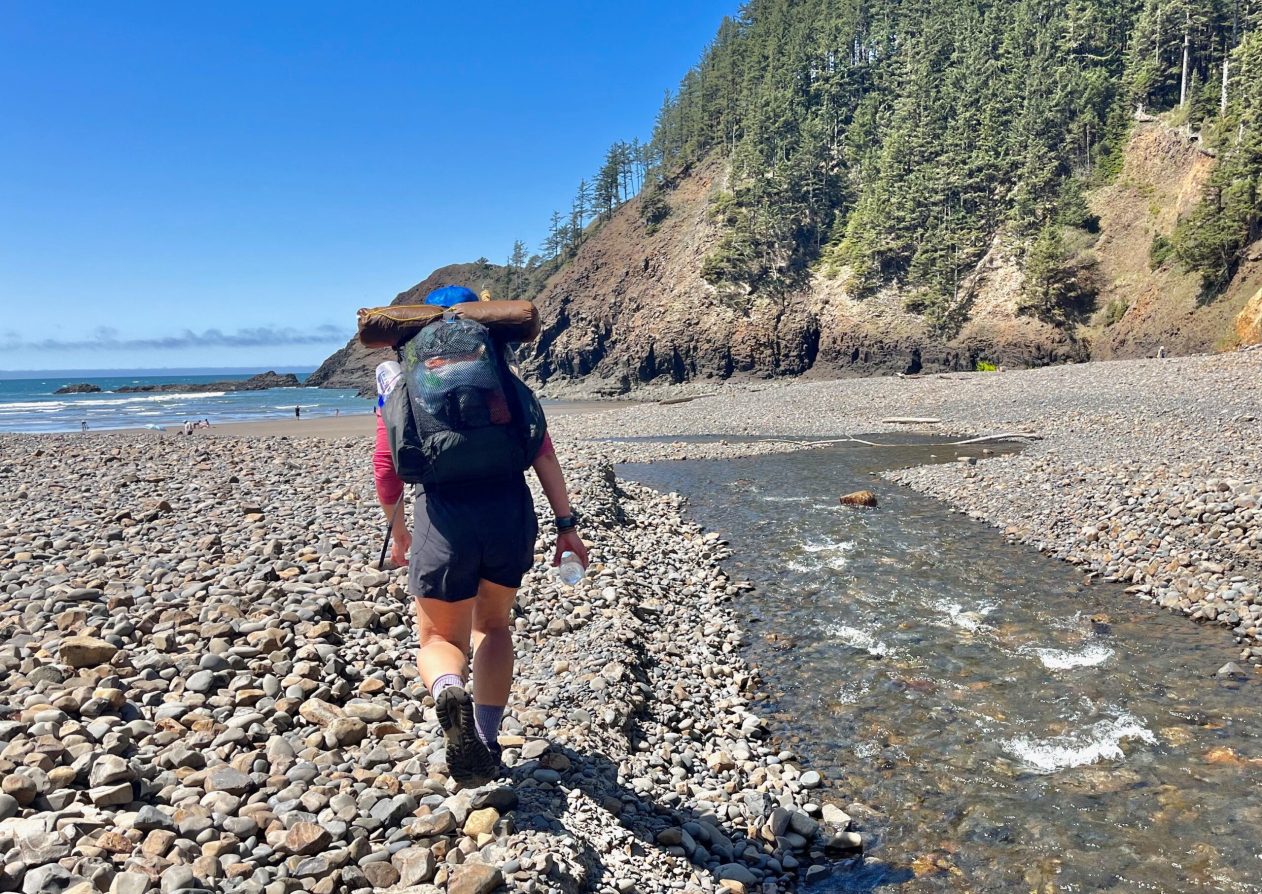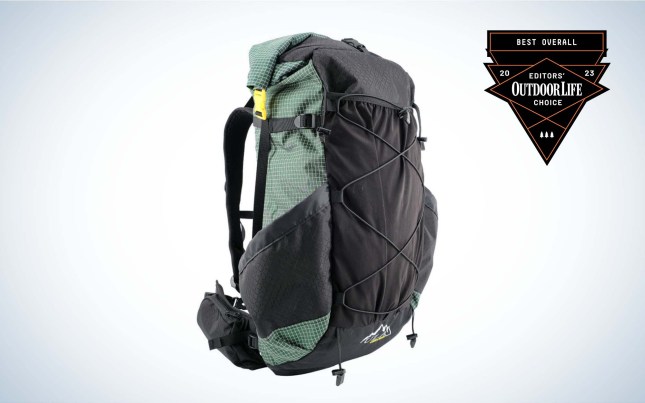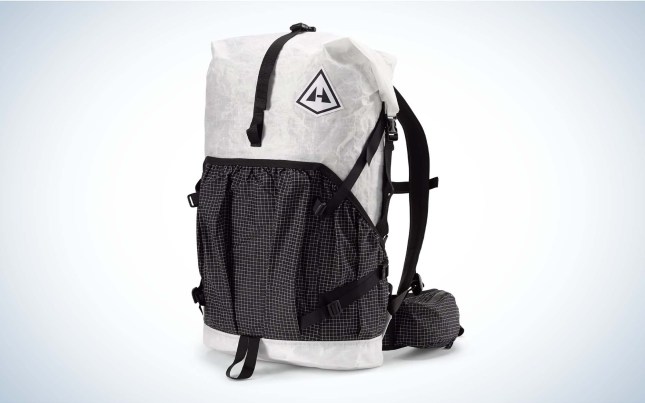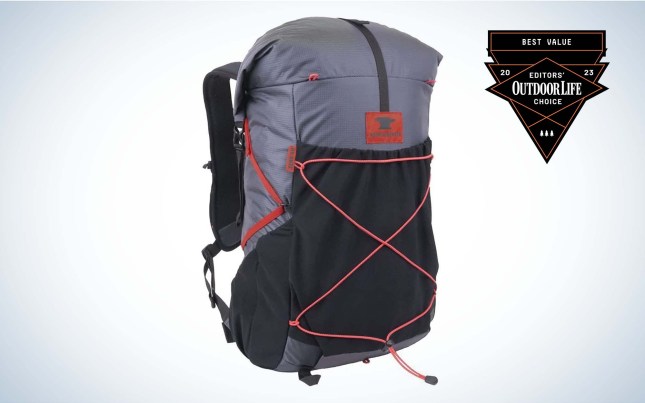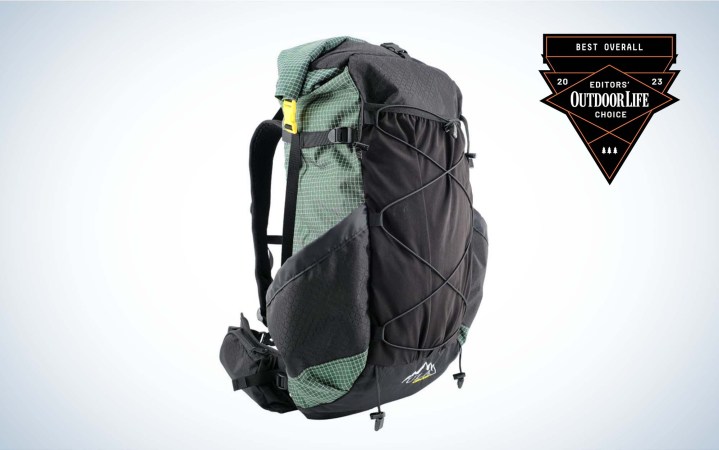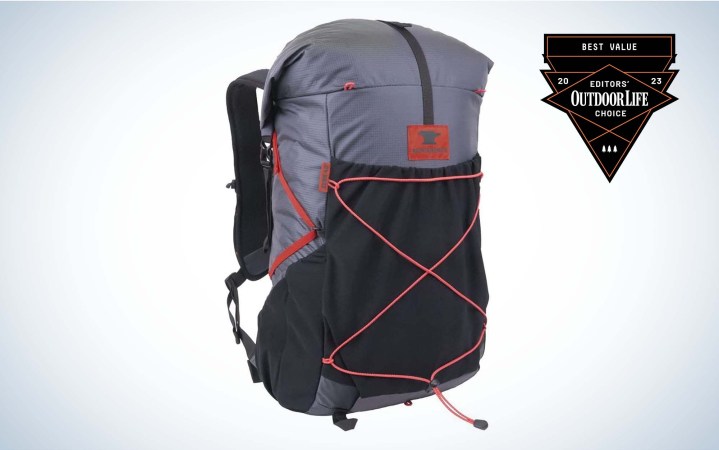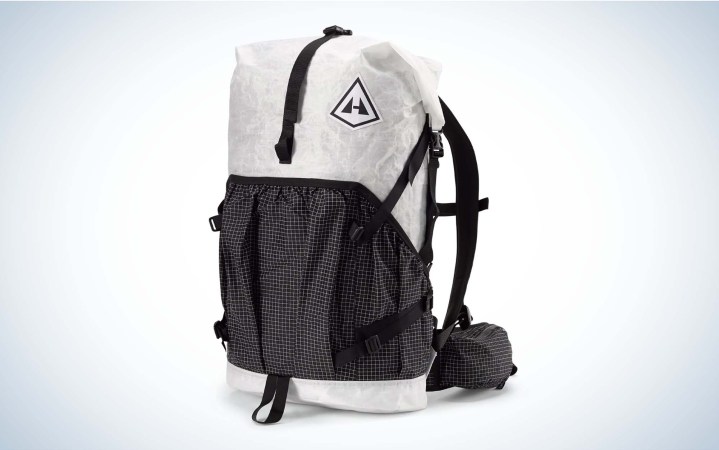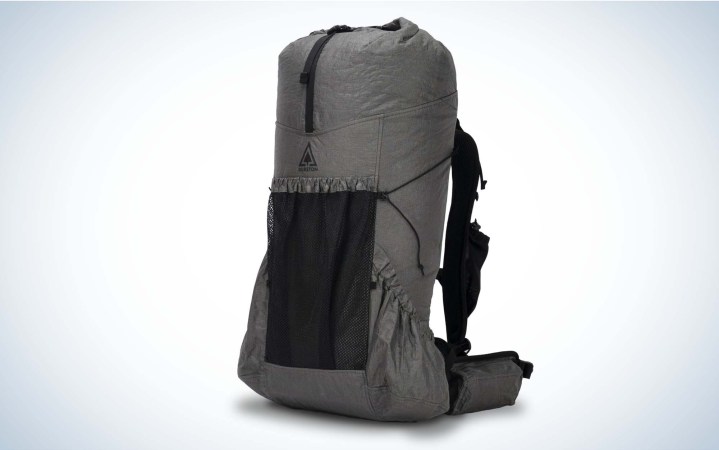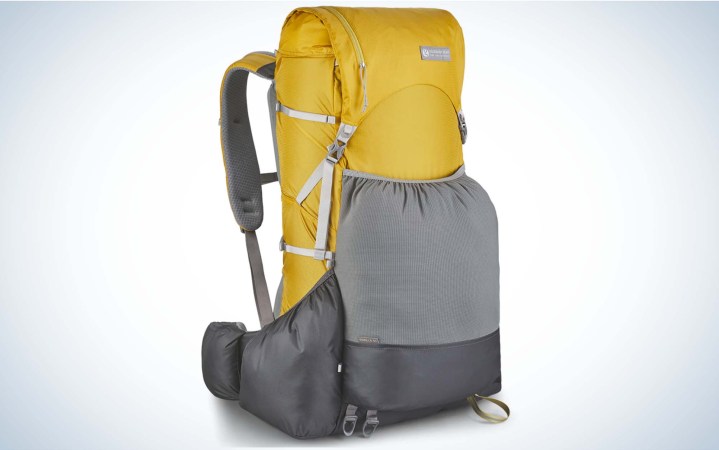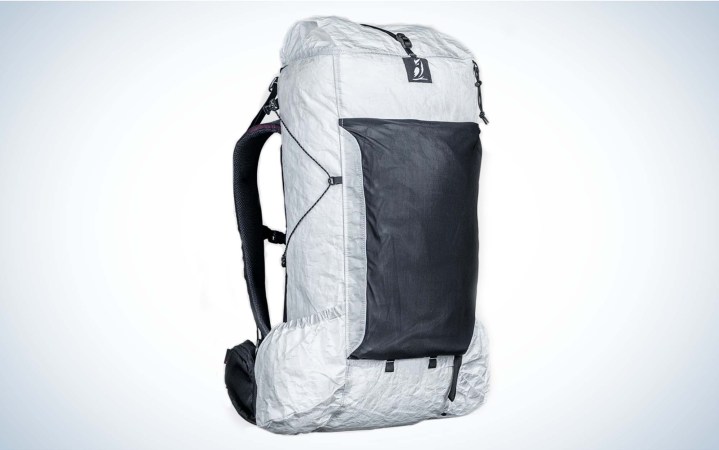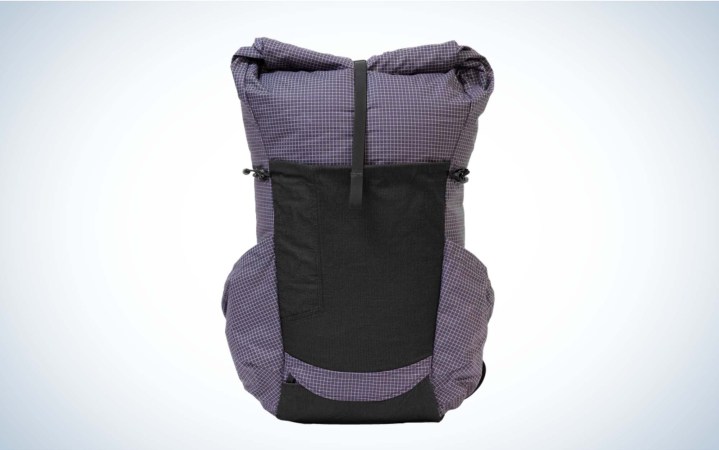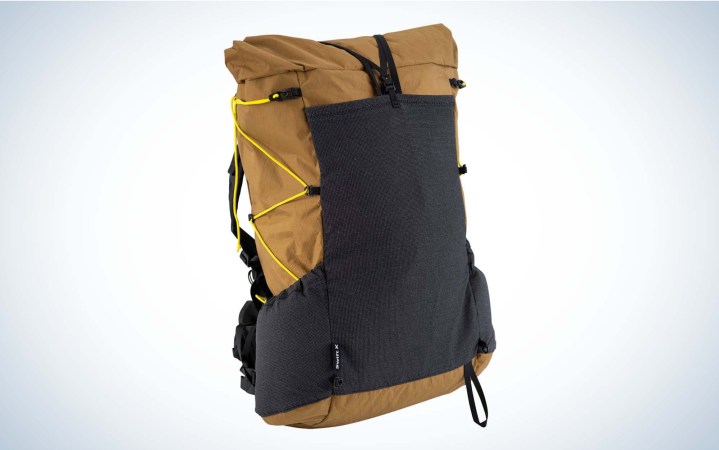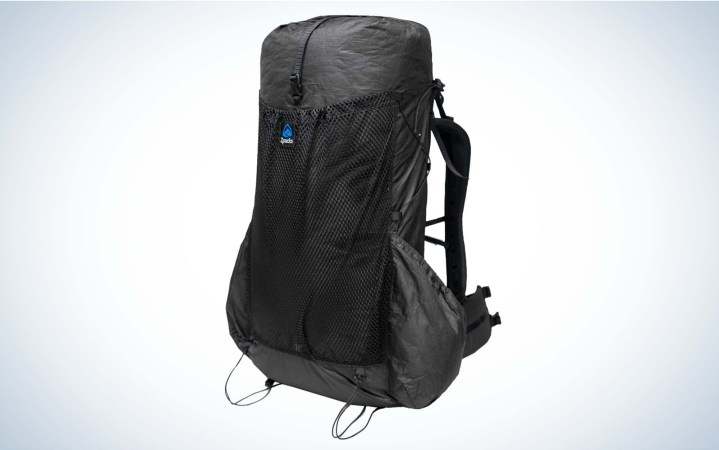We may earn revenue from the products available on this page and participate in affiliate programs. Learn More ›
For decades, long-distance hikers have skipped over more traditional framed packs in favor of a newer breed of ultralight backpacks. This style of backpack not only eschews sleeping bag compartments and top lids, but sometimes even metal frames, load lifter straps, and—occasionally—hip belts. The result often lands well below the 2.5-pound weight threshold necessary to create a truly ultralight backpacking kit. To find out which of these innovative packs could go the distance (and which were just plain uncomfortable), five testers took nine of the best ultralight backpacks on a section hike of the 362-mile Oregon Coast Trail.
- Best Overall: ULA Circuit
- Best Value: Mountainsmith Zerk
- Best Availability: Hyperlite 2400 Southwest
- Best Ultra: Durston Kakwa 40
- Best Features: Gossamer Gear Gorilla
- Best Back Panel: Outdoor Vitals CS40 Ultra
- Best for Fastpacking: Palante Desert
- Most Comfortable: Six Moon Designs Swift X
- Lightest: Zpacks Ultra Arc Haul
How We Tested the Best Ultralight Backpacks
Like with our test of the best ultralight tents, one of the challenges of choosing an ultralight backpack is that it’s difficult to try out these packs side by side. The most popular models are sold by smaller cottage companies that are household names for thru-hikers and virtually unknown to everyone else. Don’t look for the packs from ULA, Zpacks, Gossamer Gear, or Palante in REI or Cabela’s; they don’t carry them.
| Backpack | Price | Weight | Material | Warranty |
| Durston Kakwa 40 | $250 | 27.3 oz | Ultra 200 | 1 Year |
| Gossamer Gear Gorilla 50 | $255 | 30.4 oz | 70D Robic | 1 Year* |
| Hyperlite 2400 Southwest | $370 | 30.8 oz | DCH 50 or 150 | 1 Year |
| Mountainsmith Zerk | $220 | 29 oz | 210D Nylon Ripstop | Lifetime |
| Outdoor Vitals CS40 Ultra | $370 | 27 oz | Ultra 200 | Lifetime |
| Palante Pack Desert | $240 | 19.4 oz | 210D Gridstop or 400D Ultra | 2 Years |
| Six Moons Designs Swift X | $375 | 38.8 oz | LiteSkin LS21 or EPX 200 | Limited Lifetime** |
| ULA Circuit | $280 ($380 in Ultra) | 37.3 oz (33.8 oz in Ultra) | 400D Robic or Ultra 200/400 | Lifetime |
| Zpacks Arc Haul Ultra 40 | $400 | 18.8 oz | Ultra 200 | 2 Years |
**offers repairs to normal wear and tear for a fee
To help you choose the right ultralight pack for your needs and experience, five OL contributors and editors with over 20,000 miles of thru-hiking experience headed to the Oregon Coast Trail to test ultralight backpacks over three days in late April.
The Test Team
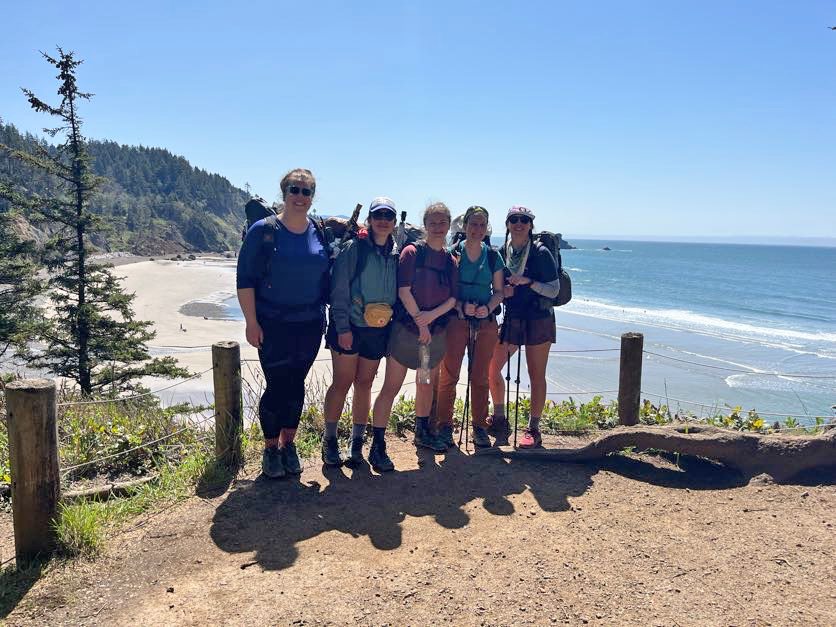
While everyone on our testing team is an experienced backpacker, we purposefully selected a panel with different preferences and total lifetime mileage. During testing, the backpacks that people chose to use (or that I suggested they try out) ended up falling into two camps: those that appealed to more traditional backpackers and those that appealed to committed ultralight backpackers. While I have included the aggregate ratings from the test, it’s also worth drilling down which user used which pack, as the expectations for load bearing and accessibility varied considerably between these camps.
- Laura “Chop Chop” Lancaster, Outdoor Life staff writer. Over 4,000 miles of backpacking experience, including the PCT 2014 and CT 2017. Previous go-to ultralight backpacks include the ULA Catalyst and Osprey Talon.
- Diana Helmuth, author of How to Suffer Outside (National Outdoor Book Award winner). Over 1,500 miles of backpacking experience. Previous go-to traditional backpacks include the Dana Designs ArcFlex Terraplane.
- Jac “Top Shelf” Mitchell. Over 11,000 miles of backpacking experience including the PCT 2014, CDT 2016, AZT, 2017, and GET 2017. Previous go-to ultralight backpacks include the Six Moon Minimalist, Mountain Laurel Designs Burn, and Gossamer G4.
- Patrice “Steady” La Vigne, gear reviewer and Denali guide. Over 7,000 miles of backpacking experience, including the AT 2011 and Te Araroa 2014-2015. Previous go-to traditional backpacks include the Gregory Deva and Osprey Aura.
- Ashley Thess, Outdoor Life assistant gear editor. Over 500 miles of backpacking experience. Previous go-to ultralight backpacks include the ULA Ohm.
How We Graded the Ultralight Packs
The backpacks we chose for this test all weighed less than 2.5 pounds and were designed for lightweight or ultralight thru-hikers, whose base weight would be about 20 pounds or 10 pounds, respectively. Base weight refers to the weight of your kit without food and water. However, that is where their similarities ended: The ultralight backpacks we looked at spanned a range of approaches to providing support, structure, and comfort. We had each tester change packs each day (and would frequently spend a mile or so trying out someone else’s pack) to get as wide a range of feedback and experience as possible. (Differing torso lengths meant not every pack could be shared with every tester.)
Each ultralight backpack was evaluated in three categories and given a score of 1 (poor) to 5 (excellent) from each person who tested it. After discussing the scores and relative merits of each ultralight backpack, we then determined and agreed upon the awards as a group. We evaluated packs for the following categories:
- Fit: Were the testers able to adjust the pack to fit their bodies?
- Comfort: Did the ultralight backpack produce any hot spots or soreness while hiking? Did they look forward to taking it off or did they leave the backpack on during breaks?
- Load Bearing: We measured how heavy our backpacks were each day before heading out to see how well they handled our typical loads, which ran between 15 and 30 pounds.
- Packability: We looked at whether we could fit our typical gear kit into each backpack and how easy (or difficult) it was to balance the load.
- Accessibility: How easily could we get at our gear during the day?
- Value: Was the pack worth the price tag for the features it provides?
Finally, a note on stated capacity. It’s not an original observation that the stated volume of a backpack does not necessarily correspond with what its actual volume is. While we did not conduct independent verification of each backpack’s stated capacity, we did check to see whether each pack fit the amount of gear that we expected it to, and noted which would require a smaller volume kit to function.
Average Tester Ratings
| Backpack | Fit | Comfort | Load Bearing | Packability | Accessibility | Value |
| Durston Kakwa 40 | 2.5 | 2.5 | 3 | 3 | 4 | 4 |
| Gossamer Gear Gorilla 50 | 4 | 3 | 3 | 4 | 5 | 3 |
| Hyperlite 2400 Southwest | 4 | 4 | 5 | 4 | 4 | 3 |
| Mountainsmith Zerk | 4.5 | 4.5 | 4 | 4 | 4 | 4.5 |
| Outdoor Vitals CS40 | 4 | 4 | 4 | 3.5 | 3.5 | 4 |
| Palante Pack Desert | 4 | 4 | 3 | 5 | 3 | 4 |
| Six Moons Designs Swift X | 5 | 5 | 4 | 4 | 3 | 4 |
| ULA Circuit | 4.7 | 3.9 | 4.7 | 4 | 3.7 | 4 |
| Zpacks Arc Haul Ultra 40 | 3 | 3 | 4 | 3 | 2 | 2 |
Best Ultralight Backpacks: Reviews & Recommendations
Best Overall: ULA Circuit
Report Card (Tested by Laura Lancaster, Patrice La Vigne, and Diana Helmuth)
- Fit: 4.7
- Comfort: 3.9
- Load Bearing: 4.7
- Packability: 4
- Accessibility: 3.7
- Value: 4
Key Features
- Warranty: Lifetime
- Weight: 37.3 ounces (33.8 in Ultra)
- Available Torso Sizes: S to XL (15 inches to 24 inches)
- Available Hip Belt Sizes: XS to XXL (26 to 47 inches)
- Shoulder Straps: J-straps or S-straps
- Adjustment Points: Hip belt, shoulder straps, load lifters, and sternum straps
- Frame: Foam with a 1.2 oz carbon fiber and Delrin suspension hoop and a single aluminum stay
- Body Material: Available in Robic or Ultra
- Pockets: Two hip belt pockets, two side pockets, one large back pocket
Pros
- Available in high-performing Ultra fabric or more cost-effective Robic
- Can handle large, heavy loads while scaling down for smaller carries
- Wide range of sizing options makes it easier to get the right fit
- Customizable if you want bottom straps, ice ax loops, etc.
Cons
- Limited pockets compared to other models we looked at
There was some controversy with this one. ULA is a mainstay of the ultralight backpacking world, and their packs are regularly seen on long trails across the country. In a lot of ways, they epitomize what ultralight packs are all about: ULA packs pare away everything but the bare essentials. They test the limit of how little structure and frame you can get away with across a range of load weights. They’re tough and durable enough to go the distance on not one but multiple thru-hikes. ULA also has a lifetime warranty, and—unlike other so-called warranties—thru-hikers have reported that ULA stands by their policy. (One Triple Crowner told us for our story on the best thru-hiking backpacks that ULA offered to send her a brand-new pack after the liner of her ULA Circuit wore down.) The ULA Circuit was also the only pack we looked at where you could choose to keep the price down with the time-tested Robic fabric or upgrade to the best-in-class Ultra, a $100 price difference.
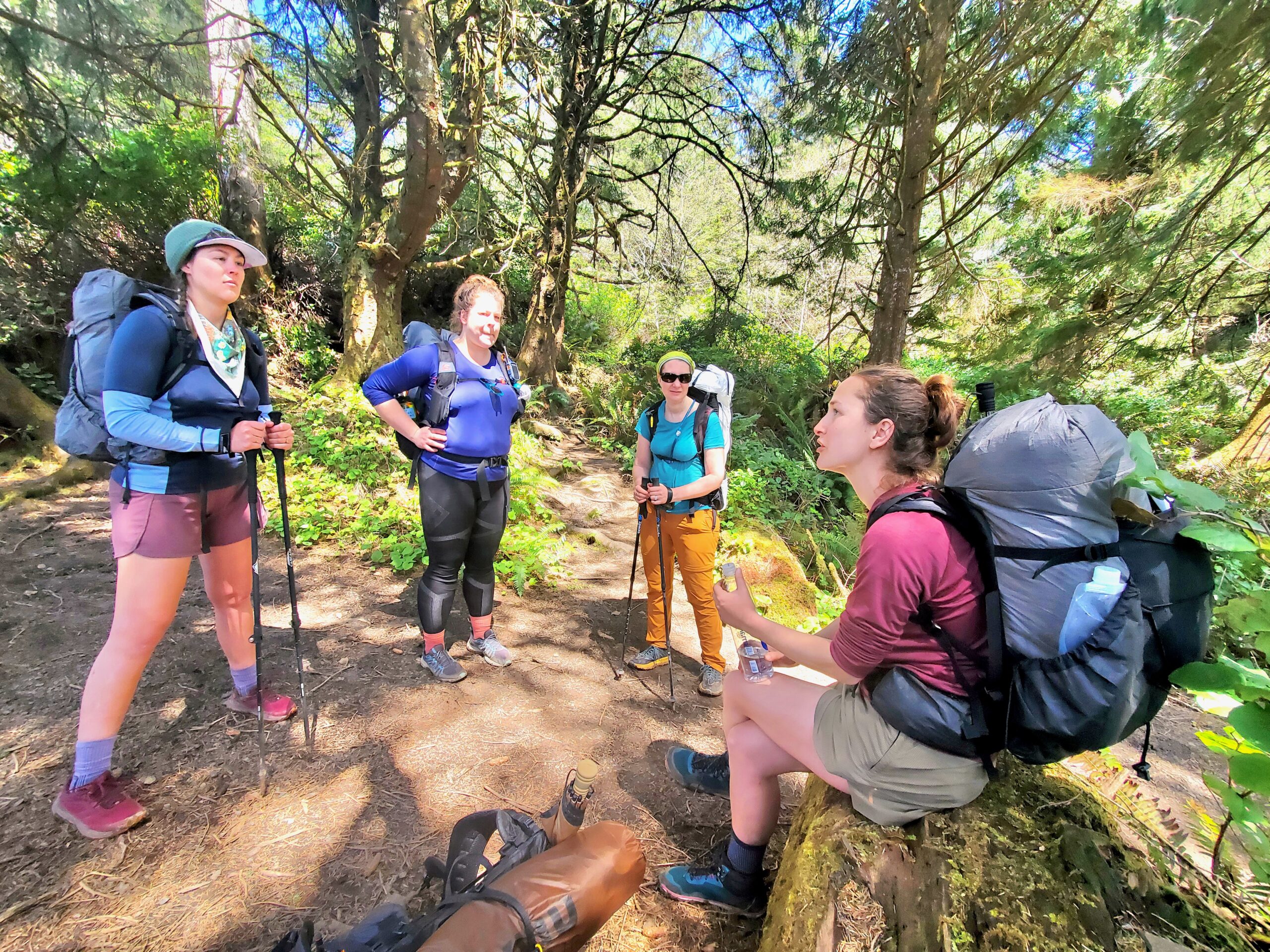
Ultra is a comparatively newer fabric in the ultralight landscape, that meets or exceeds the durability and waterproofness ability of other best-in-class fabrics while weighing significantly less. It’s also significantly more expensive. We tested a number of packs that used this fabric, including the Durston Kakwa 40, the Palante Desert, Outdoor Vitals CS40, and Zpacks Ultra Arc Haul. One difference with the ULA Ultra Circuit is that in addition to using Ultra 200 (as opposed to 100) on the body of the pack, the bottom is reinforced with Ultra 400 for extra durability. Whether the weight savings (and promised waterproofness) of the Ultra material is worth the extra cost is ultimately a matter of preference—either option would be an excellent choice that would serve you well for multiple thru-hikes.
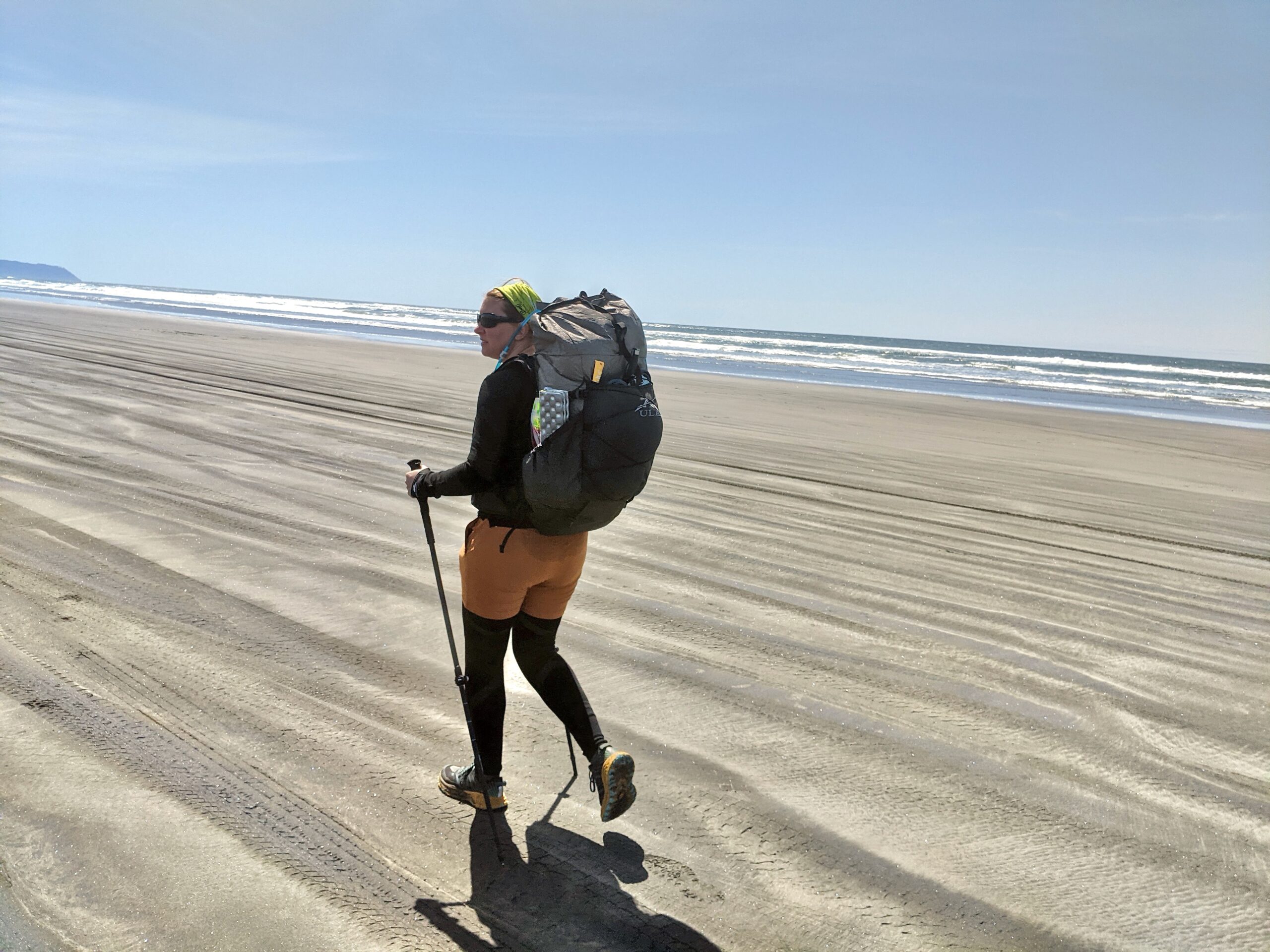
The level of support the ULA Circuit provides is perfect for the 30-pound loads typical of long water carries in the desert of the Pacific Crest Trail or the food haul needed for the 100 mile wilderness on the Appalachian Trail. While other ultralight backpacks in this test dispensed with any sort of frame or structure to the back panel, the ULA Circuit has a hoop running along the outer edges up across the top of the back mesh panel and then meeting again at the bottom. This provides an exceptional level of support for its minimalist design. We had one tester, Diana Helmuth, who is new to ultralight gear (she typically uses traditional backpacking backpacks, like the Deuter Aircontact) and she reported that she was impressed that the ULA Circuit caused her zero pain points and was similarly amazed at how well this pack handled the load.
I used the ULA Catalyst (the big brother to the Circuit) years ago on a thru-hike of the Pacific Crest Trail, but hadn’t picked up a ULA since. When it was my turn to test the ULA Circuit on the third day of testing I was surprised by how much I still liked this style of pack. It swallowed all my gear and cinched down effortlessly around it. The shoulder straps and hip belt were cushioned without overdoing it, the back panel was firm without being stiff. Even though it was the third day of testing, it was the most comfortable carry of the whole testing trip. If I was heading out on a thru-hike with significant water or food carries tomorrow, this is the pack I would bring with me. When I asked assistant gear editor, Ashley Thess, if she would be trading in her current ULA pack (an Ohm) for any of the lighter models she tried out during testing, the answer was a resounding no. Part of what makes the ULA packs so popular is that they are both a great entry-level ultralight backpack and a great choice for the third hike of your Triple Crown.
But not everyone loved it. Patrice La Vigne, who has completed both the Appalachian and Te Araroa Trails, said she is sticking with her go-to Gregory Deva, a traditional-style backpack. For her, the comparatively minimalist pockets and access points on the ULA Circuit disrupted her system for packing and accessing gear on trail—and the weight savings of the pack didn’t make that worth the headache. Other testers noted, too, that the pockets on the ULA Ultra Circuit that we tested had less give than other ultralight backpacks we looked at (including the Robic version of ULA’s packs).
Something the ULA Circuit drove home for this testing group is that the switch to ultralight backpacks is not just about cutting weight from your kit; it’s about reimagining your relationship with your backpack and, by extension, your gear. Most of us that spend significant time in the backcountry have developed countless routines that we barely register: how we prep our coffee in the morning, how we organize the inside of our tents—and how we get into and out of our backpacks. These routines aren’t small things; they are what keeps us going on days when 20 mile per hour wind is sandblasting you in the face (as happened on the second day of our testing trip).
So if Patrice’s frustrations with the top-entry-only access and scant pockets of the ULA Circuit resonate with you, then our recommendation is to give ultralight backpacks a pass, at least for now.
But if you’re prepared to really rethink your relationship to your backpack, then we think the ULA Circuit is the place to start. All our testers were impressed with how comfortable it was, even with heavier loads, both compared to traditional-style backpacks and compared to other ultralight models we looked at. So even if you’re just getting started on your ultralight journey, and haven’t yet upgraded to the best ultralight tent or the best ultralight quilt, this pack will work for the kit you have now, and the kit you have in the future. Plus its warranty-backed durability means that you may never need to switch it out.
Read Next: Best Backpacking Backpacks
Best Value: Mountainsmith Zerk
Report Card (Tested by: Patrice La Vigne and Diana Helmuth)
- Fit: 4.5
- Comfort: 4.5
- Load bearing: 4
- Packability: 4
- Accessibility: 4
- Value: 4.5
Key Features
- Warranty: Lifetime
- Weight: 29 ounces
- Available Torso Sizes: One size only (16 inches to 19 inches)
- Available Hip Belt Sizes: One size only (one size fits all up to 48 inches)
- Shoulder Straps: Running vest style
- Adjustment Points: Hip belt (removable), shoulder straps, sternum strap
- Frame: Frameless (foam back)
- Body Material: 210D nylon ripstop
- Pockets: Four shoulder strap pockets, four side pockets, one front mesh pocket
Pros
- Affordable (includes lifetime warranty)
- Comfortable
- Great pockets
Cons
- One size fits all may not work for everyone
- Somewhat heavy for a smaller frameless pack
Like the ULA Circuit, the Mountainsmith Zerk divided our testers. The committed ultralight-pack enthusiasts took one look at the double-mesh pockets, the spongy back panel (the only structure to the pack is a thin piece of foam), and thicker nylon body and grabbed something else. It just didn’t have the features they look for in an ultralight backpack.
The other half, who typically wear traditional-style backpacks, picked it up almost immediately. After struggling to pack the ULA Circuit, they appreciated the extra storage options provided by all the mesh pockets.
“I was worried that the pack didn’t have hipbelt pockets, but I honestly didn’t need them because there were four side mesh pockets, four chest mesh pockets, and one large mesh pocket plus bungees on the back,” said La Vigne. “I love pockets and proper organization and there was a place for everything.”

The flexible fabric of the body of the pack was easy to root around in compared to the other packs we looked at and the roll-top closure cinched down tight with one simple buckle. Then we told them that, at $220, it was the lowest priced pack in the entire test: that sealed the deal for the value award. By comparison, the Robic version of our best overall pick is $280 and the most expensive in this test (the minimalist Zpacks Ultra Arc Haul) is $400—almost twice the price for about 10 ounces of weight savings. While we looked carefully at the Durston Kakwa 40 for this award, which was only $40 more expensive and made from best-in-class Ultra, neither of that pack’s testers were sufficiently enthusiastic to warrant it.
And that hip belt that the other testers gave a side eye to? They said it worked great, moving the weight off their shoulders sufficiently—including 30 pounds the day we climbed 1,200 feet onto a bluff). They didn’t even complain about the lack of load lifters. While the Mountainsmith Zerk is typically targeted at ultralight fastpackers, our testers’ feedback shows that more traditional backpackers looking to experiment with ultralight benefit most from this affordable option. The only major downside to this pack is that it has a one-size fits all torso length that will only work for a subset of backpackers.
Best Availability: Hyperlite 2400 Southwest
Report Card (Tested by Ashley Thess with additional input from Jac Mitchell)
- Fit: 4
- Comfort: 4
- Load bearing: 5
- Packability: 4
- Accessibility: 4
- Value: 3
Key Features
- Warranty: One year
- Weight: 30.8 ounces (31.9 ounces for DCH150)
- Available Torso Sizes: XS to L (15 inches to 21 inches)
- Available Hip Belt Sizes: XS to L (26.5 inches to 52 inches) (hip belts cannot be swapped between torso sizes)
- Shoulder Straps: J-straps only
- Adjustment Points: Hip belt, shoulder straps, sternum strap
- Frame: Two removable, contoured aluminum stays
- Body Material: DCH50 or DCH150
- Pockets: Two hip belt pockets, two side pockets, one large back pocket
Pros
- Available in brick and mortar stores
- Lightweight
- Great load bearing for its weight
Cons
- Expensive
- Sternum strap was abrasive to our tester
- Limited warranty
Hyperlite is one of the most well-known names in ultralight gear, and it’s one of the few sold in brick-and-mortar stores. So we were curious to see how it would stack up next to the cottage companies. If you try out a Hyperlite pack in an REI and love it, does that mean you should go ahead and buy it? Or would it be better to take a gamble on another pack in this list?
After testing the Hyperlite 2400 Southwest, we feel confident that you should trust your gut and buy that Hyperlite. It’s comfortable even with the heavier end of ultralight loads (one tester carried 24 pounds in this pack over 15 miles). Despite having only two aluminum stays and no load lifters, our tester said she was able to forget about the pack on her shoulders—the highest of praise, in our opinion.
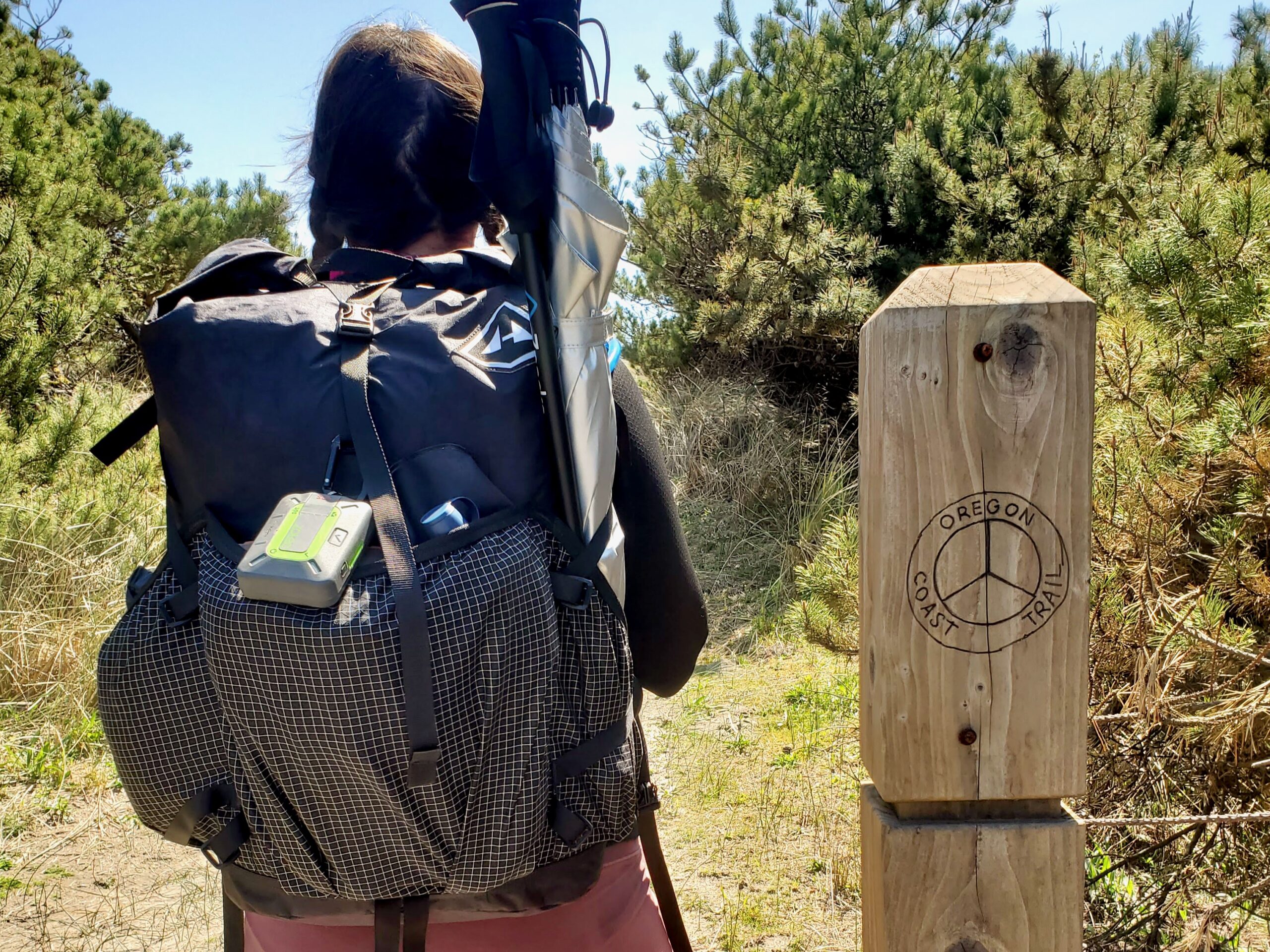
It also scored high for its accessibility, as it had all of the pockets (two hip belt pockets, two side pockets and a giant front pouch held closed with an elastic band) we look for from an ultralight backpack, and none of the ones that add extra weight without increasing functionality.
One thing to note is that, unlike the other ultralight backpacks at this price point, the Hyperlite is made from DCH rather than Ultra. DCH is a laminated version of Dyneema Composite Fabric (DCF), which has many of the same qualities as Ultra. The only concrete difference between the two is that DCH tends to look the worse for wear over time, although its performance is typically unaffected.
So what are the downsides of this pack? It’s a few ounces heavier than the other packs in Ultra that we looked at (although lighter than the more frame-intensive ULA Circuit). Despite their widespread availability and ubiquity, there isn’t the option to switch to S straps (although our tester did note that the J straps were less extreme than on other ultralight backpacks). The sternum strap is also only minimally adjustable, and for Thess it was pitched too high. She reported needing to stash a bandana underneath to prevent chafing. Finally, it has a limited warranty—only one year.
Read Next: Hyperlite Southwest 40 Ultralight Backpack Review
Best Ultra: Durston Kakwa 40
Report Card (Tested by Jac Mitchell and Ashley Thess with additional input from Laura Lancaster)
- Fit: 2
- Comfort: 2
- Load bearing: 3
- Packability: 3
- Accessibility: 4
- Value: 4
Key Features
- Warranty: one year
- Weight: 27.3 ounces
- Available Torso Sizes: S to L (14.5 inches to 21.5 inches)
- Available Hip Belt Sizes: S to L (28” to 40”) (hip belts cannot be swapped between torso sizes)
- Shoulder Straps: S shoulder straps
- Adjustment Points: Hip belt, shoulder straps, load lifters, sternum strap
- Frame: Inverted hollow-aluminum U frame
- Body Material: 200D Ultra
- Pockets: two hip belt pockets, two side pockets with vertical zip pocket on the left side, back mesh pocket
Pros
- Great pockets
- The most affordable backpack in Ultra that we looked at
Cons
- Lack of structure along the back panel requires careful packing
The Durston Kakwa 40 is an experienced ultralight backpacker’s dream. It’s lightweight (27.3 ounces for a medium). It has enough structure to manage heavier loads. It’s got all the pockets you’d expect (plus one extra). It’s made with Ultra, giving you that extra durability and additional waterproofness. And it’s extremely reasonably priced.
While the Durston Kakwa 40 has a frame that’s similar to the ULA Circuit, what it doesn’t have is a foam backing. On most of the back panel, there’s just a thin piece of Ultra fabric between you and the interior contents. Ashley struggled with the lack of structure, reporting that a bulge against her back all day was annoying. Like all frameless, or unpadded, backpacks, even slightly less than ideal packing is going to result in serious discomfort. If you’re going frameless for the first time, pay attention to how you’re structuring the items in the Durston Kakwa 40.
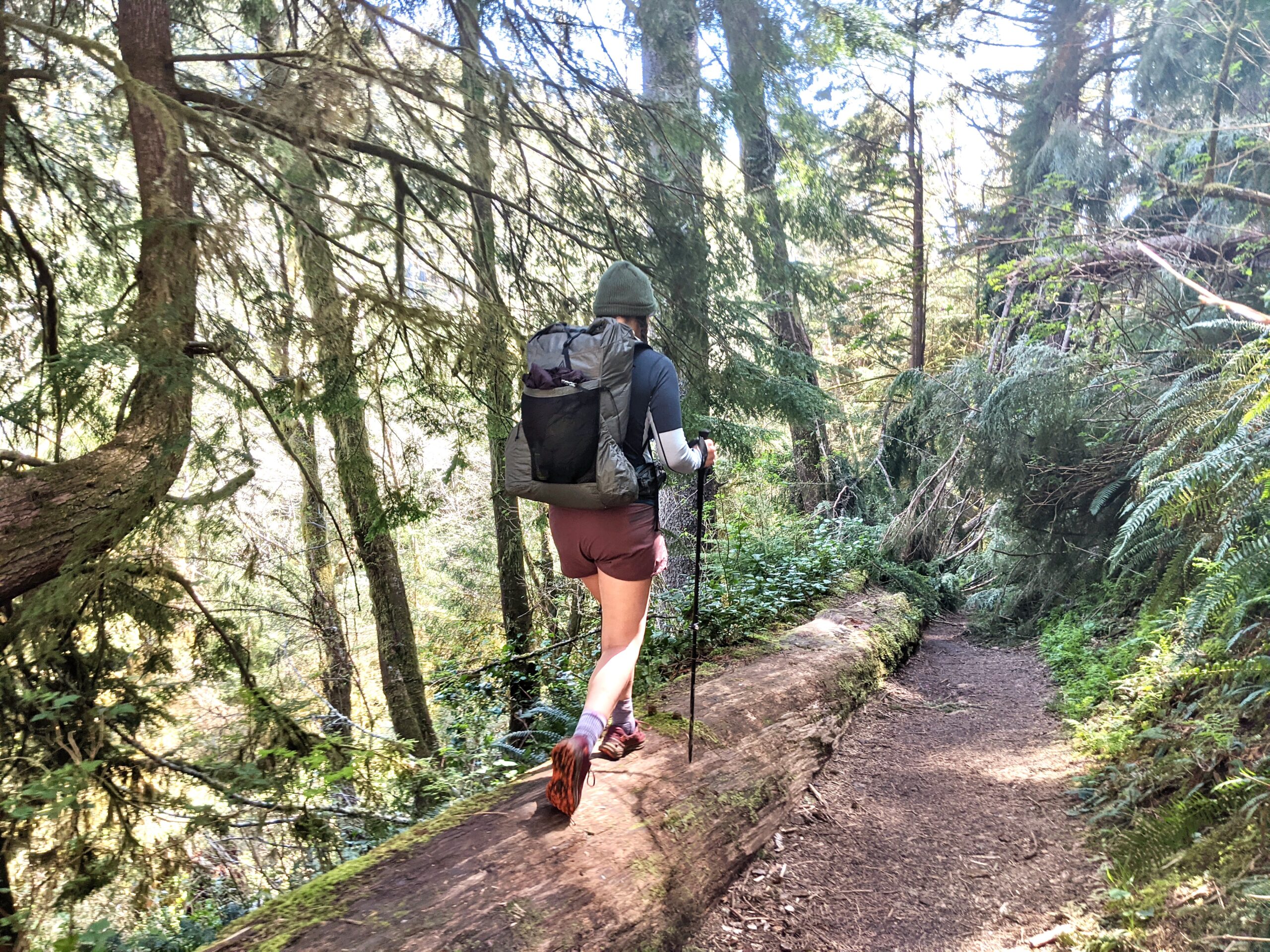
Jac, conversely, found the structure to be almost too stiff. While it wasn’t uncomfortable, it was more noticeable than other packs we looked at. After the testing trip, I loaded this pack up with about 35 pounds to see how it would handle the load. (35 pounds is what you should expect to carry in the desert with an all-day water carry but an otherwise ultralight load.) Whereas the pack hugged around my body comfortably at 15 pounds, to get the 35-pound balanced between my hips and my shoulders it had to perch more on my hips that was natural. That would be fine for a short distance (you are going to be drinking all that water, after all); this is not the pack for someone who plans to consistently carry 35 pounds.
The testers appreciated the details of the Durston Kakwa 40. Generous hip belt pockets, side pockets, and front mesh pockets (one of the few in our test that was truly see-through) made stashing items on the go a breeze. There was also a bonus zip pocket along one of the side pockets for easy access to larger items that don’t fit in your side pocket. Our only ding on the features were the side compression straps, which were somewhat difficult to tighten and release.
Best Features: Gossamer Gear Gorilla
Report Card (Tested by Laura Lancaster)
- Fit: 4
- Comfort: 3
- Load bearing: 3
- Packability: 4
- Accessibility: 5
- Value: 3
Key Features
- Warranty: One year, does not include defects related to durability issues or fabric failure
- Weight: 30.4 ounces
- Available Torso Sizes: Small to large (11.5 inches to 23.5 inches)
- Available Hip Belt Sizes: Small to large (22 inches to 50 inches)
- Shoulder Straps: J-straps
- Adjustment Points: Hip belt, shoulder straps, sternum strap
- Frame: Removable mesh back panel that doubles as a sit pad
- Body Material: 70D Robic
- Pockets: Two hip belt pockets, two side pockets, back mesh pocket, zip pocket on lid
Pros
- Stretchy mesh storage pockets fits almost anything
- Padded hip belts and shoulder straps felt comfortable out of the box
- Fits a smaller torso size than anything else we looked at.
Cons
- Heavier loads may result in some shoulder strain
- Utilizing the zippered pocket on the lid can limit access to the main compartment
While ultralight backpacks are typically associated with a dearth of features, we’ll make an exception for the thoughtful touches of the Gossamer Gear Gorilla. Cushioned shoulder straps. A zip pocket on the top lid (perfect for storing car keys and a wallet). A removable pack panel that doubles as a sit pad. And the stretchiest front mesh pocket we used on the testing trip.
The front mesh pocket had so much stretch that it not only held my base layers and odds-and-ends like sunscreen and first-aid kit, but also my camp stove and some of the best backpacking food we packed for lunch.
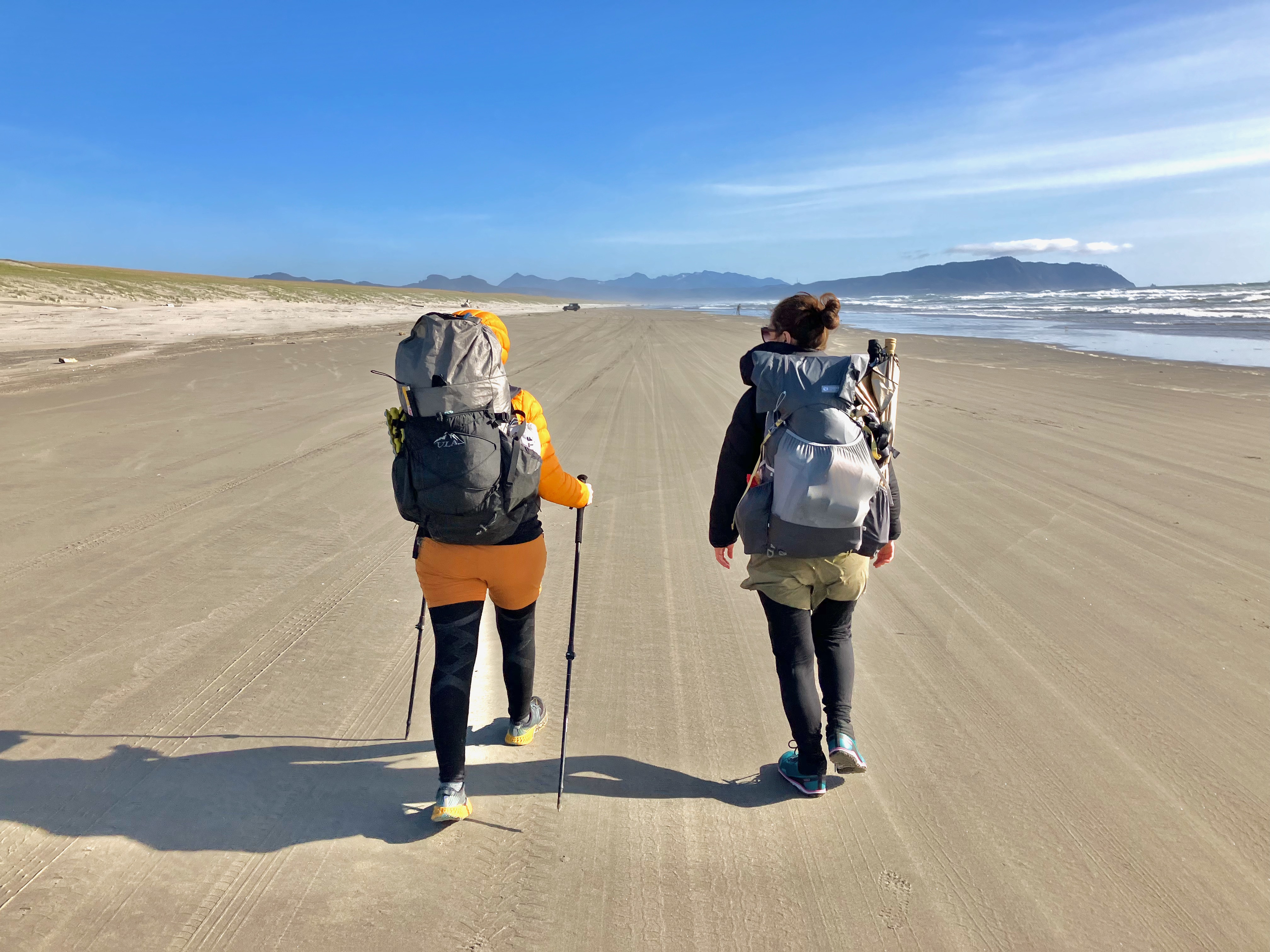
While I’m admittedly prone to overstuffing the front mesh pockets of my packs, here it was also a practical consideration because of the quirky zip pocket on the lid. Once I’d added an item or two to that pocket, it would pull on the opening to the main compartment when the lid was open, making it somewhat difficult to pack items in or take them out.
I was fine with that, to an extent. In my experience, regularly loading and unloading the entire contents of your backpack in the backcountry makes it much more likely that you’ll lose something or that essential gear will become wet or dirty. But packing so much gear into that mesh pocket (as opposed to the interior of the pack) likely contributed to my discomfort as it caused the backpack to pull back on my shoulders—an issue emphasized by the lack of load lifters on the Gossamer Gear Gorilla.
While the stated max load for this backpack is 30 pounds, my sense is that only individuals with especially strong shoulders will be comfortable carrying that weight for extended periods of time. But if the features of the Gossamer Gear have your heart (they have mine), then Gossamer Gear’s Mariposa pack—which does come with load lifters—would be a smart choice.
A final point here is to consider how many miles you plan to put on your Gossamer Gear Gorilla before committing. The fabric here was some of the thinnest we tested on this trip, and durability issues related to the fabric are not covered by Gossamer Gear’s warranty.
Best Back Panel: Outdoor Vitals CS40 Ultra
Report Card (Tested by Laura Lancaster and Patrice La Vigne)
- Fit: 4
- Comfort: 4
- Load bearing: 4
- Packability: 3.5
- Accessibility: 3.5
- Value: 4
Key Features
- Warranty: Lifetime warranty
- Weight: 27 ounces
- Available Torso Sizes: Small to large (18 inches to 22 inches)
- Available Hip Belt Sizes: Small to large (28 inches to 40 inches)
- Shoulder Straps: J straps
- Adjustment Points: hip belt, shoulder straps, load lifters, sternum strap
- Frame: back panel foam with two carbon fiber internal stays
- Body Material: Ultra 200
- Pockets: two hip belt pockets, two side pockets, back mesh pocket
Pros
- Great back panel padding and ventilation
- Roomy back mesh pocket
Cons
- Expensive
- Profile is somewhat slack
- Aggressive J straps were less comfortable for our testers
There are a lot of positives about the Outdoor Vitals CS40 Ultra. It’s lightweight, thanks in part to its 200D Ultra exterior. It has a great front mesh pocket that not only holds all of your small items, but also allows you to see where they are—decidedly not the case for all the mesh pockets we looked at. It’s got plenty of capacity and it carries loads reasonably well, producing only a minor crick in one tester’s shoulder after 10 miles and 1,200 feet of elevation gain through muddy terrain.
But where this pack really stood apart from the crowd was in its ability to manage sweat along the shoulder straps and back panel. Traditionally, the sweatiest long-distance hikers have gravitated toward Osprey’s packs, including the 40-ounce Exos, because of its best-in-class back panel ventilation. And this isn’t a small point: For some backpackers, back panel chafe can be a debilitating, hike-ending issue. That makes the vast majority of ultralight backpacks a virtual nonstarter.
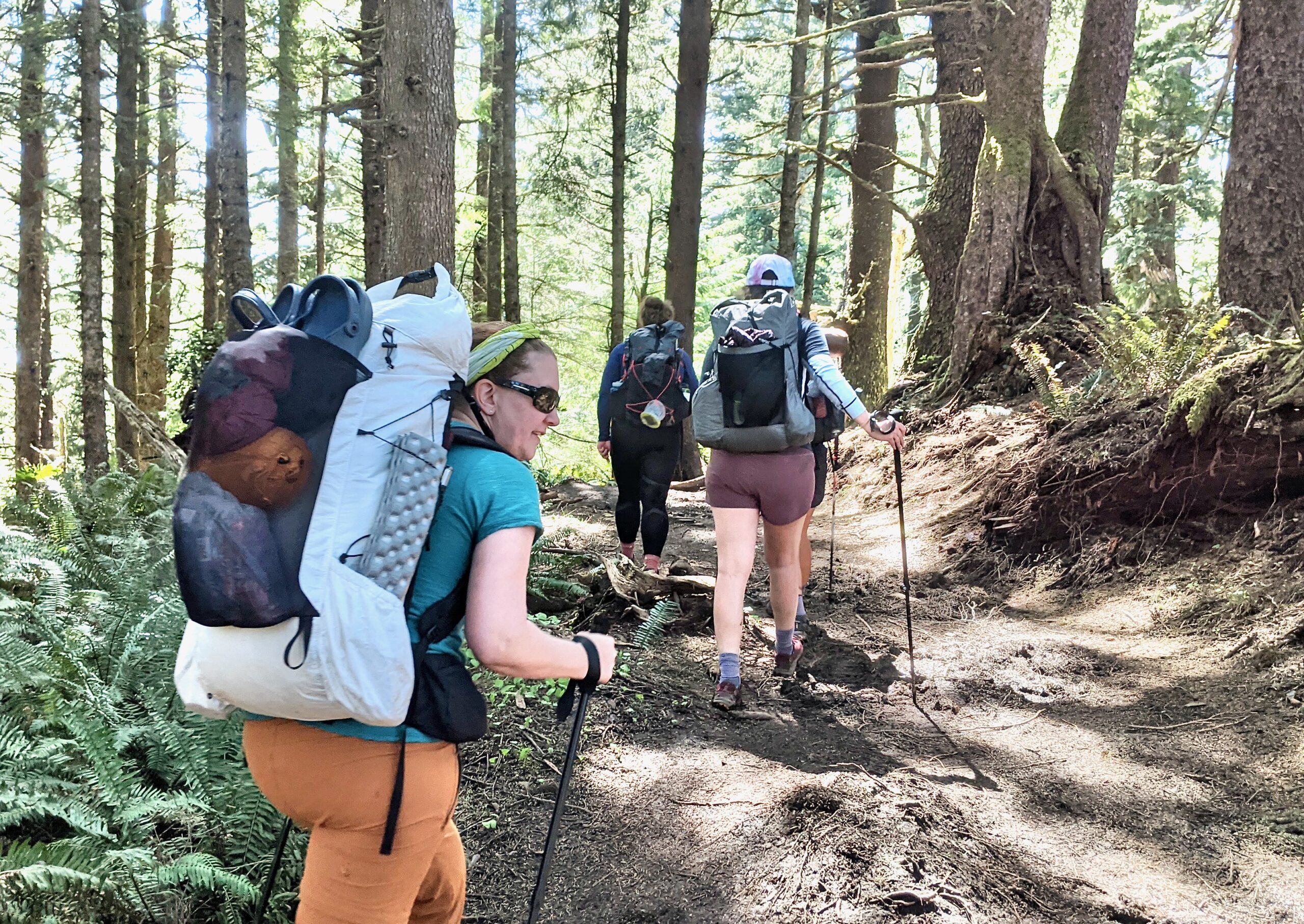
Our sweatiest tester (she says she sweats “just by looking at the sun”) took this pack out on day four, when temperatures climbed into the upper 70s right as we hit a destroyed section of trail that necessitated some bushwhacking. Not only did she find the back panel to be the most comfortable of everything she tried, but she also didn’t feel any sweat against her back. That’s because, in addition to being ventilated, the padding is also raised off the middle portion of the Outdoor Vitals CS40 Ultra, and overlaid with a mesh layer that allows some airflow to move beneath it. If you’re used to using an Osprey pack, you might be disappointed with the level of airflow provided, but if you are looking for an upgrade from a typical ultralight backpack, this is a massive improvement.
The biggest ding against the Outdoor Vitals CS40 Ultra is that it looks a little sloppy. The mesh of the front pocket is a bit loose, the roll-top bunched up, the side pockets drooped. While this is ultimately more an aesthetic concern than a practical one, at this price point we’d expect a backpack to look a lot sharper. For this testing group—all women—the aggressive J-straps also proved noticeably less comfortable than other models we tested. If your chest has any bulk to it, check out the Duston Kakwa 40 or the ULA Circuit.
Best for Fastpacking: Palante Desert
Report Card (Tested by Jac Mitchell)
- Fit: 4
- Comfort: 4
- Load bearing: 3
- Packability: 5
- Accessibility: 3
- Value: 4
Key Features
- Warranty: Two years
- Weight: 19.4 ounces (20.1 ounces for the gridstop)
- Available Torso Sizes: 17 inches or 19 inches
- Available Hip Belt Sizes: One size only, hits at waist or high hip
- Shoulder Straps: J straps
- Adjustment Points: waist belt, shoulder straps, sternum straps
- Frame: None
- Body Material: 210D gridstop or 400D ultraweave
- Pockets: One stash pocket at base, two side pockets, one front mesh pocket, two shoulder strap pockets
Pros
- Very lightweight
- Surprising capacity
- Allows for increased range of movement
- Thoughtful details
Cons
- Requires the biggest shift in approach from traditional backpacking backpacks
- Limited sizing options
Our most experienced tester, Jac Mitchell, took the Palante Desert out on the second day of our trek along the Oregon Coast Trail, covering almost 20 miles in an afternoon. She reported that she was surprised at how comfortable she found the backpack to be, given that the entire weight of the backpack was resting squarely on her shoulders. But, then again, she was only carrying 14 pounds, which included her typical kit as well as three liters of water. And that’s who the Palante Desert is for: backpackers who have already dialed their base weight down to 10 pounds or less.

While the Palante technically has a hipbelt—artfully stashed behind the side pockets—it’s nothing more than wide nylon webbing, like the Mountainsmith Zerk’s. And in the case of the Palante Desert, the hipbelt sits at your waist, so you must let out extra slack in the shoulder straps for it to reach your hips. That makes it useful for stabilizing the pack on your shoulders, but less useful for redistributing weight.
Which is probably fine, because if you are considering a pack like the Palante Desert, your base weight is likely within spitting distance of 10 pounds. Our tester reported, as expected, that much of the weight of the pack was sitting on her trapezoids. But she was impressed by the range of motion this style of backpack afforded her. The Palante Desert rides high, even for an ultralight backpack, which allows for a more open gait. The tester ended up foregoing the hipbelt, which increased her range of motion dramatically. If you are planning an off-route trail like the Sierra High Route, this would be a major advantage.
Mitchell liked the thoughtful features designed specifically for this style of backpacking. An undercarriage pouch was the perfect place to snag a bar or two while hiking. Mesh pockets on both shoulder straps fit our phones comfortably. There was even a designated stake pouch in the front mesh pocket. That makes it that much easier to stack your tent against the inside back of your pack—no pointy bits to shift and stab you in the back while hiking. One of the side pockets also ran high, useful for stashing mid-sized gear without having to worry about it falling out. She also noted that the main body of the Palante Desert seemed to swallow gear, holding much more than you would expect given its tiny profile.
I took the Palante Desert out for a four-night trip in Washington State’s Goat Rocks Wilderness and found this to be true. The Desert had plenty of space for my kit (which is ultralight, but not excessively so) and four days of food. While I did find the weight on my shoulders starting to get a bit old by the end of the second day, when I did finally pull out the waist strap—this is definitely not a hip belt—it was much more helpful than I had anticipated in distributing the load and taking the weight off my pressure points. By the end of my trek, this backpack looked no bigger than a daypack, and felt about the same as well.
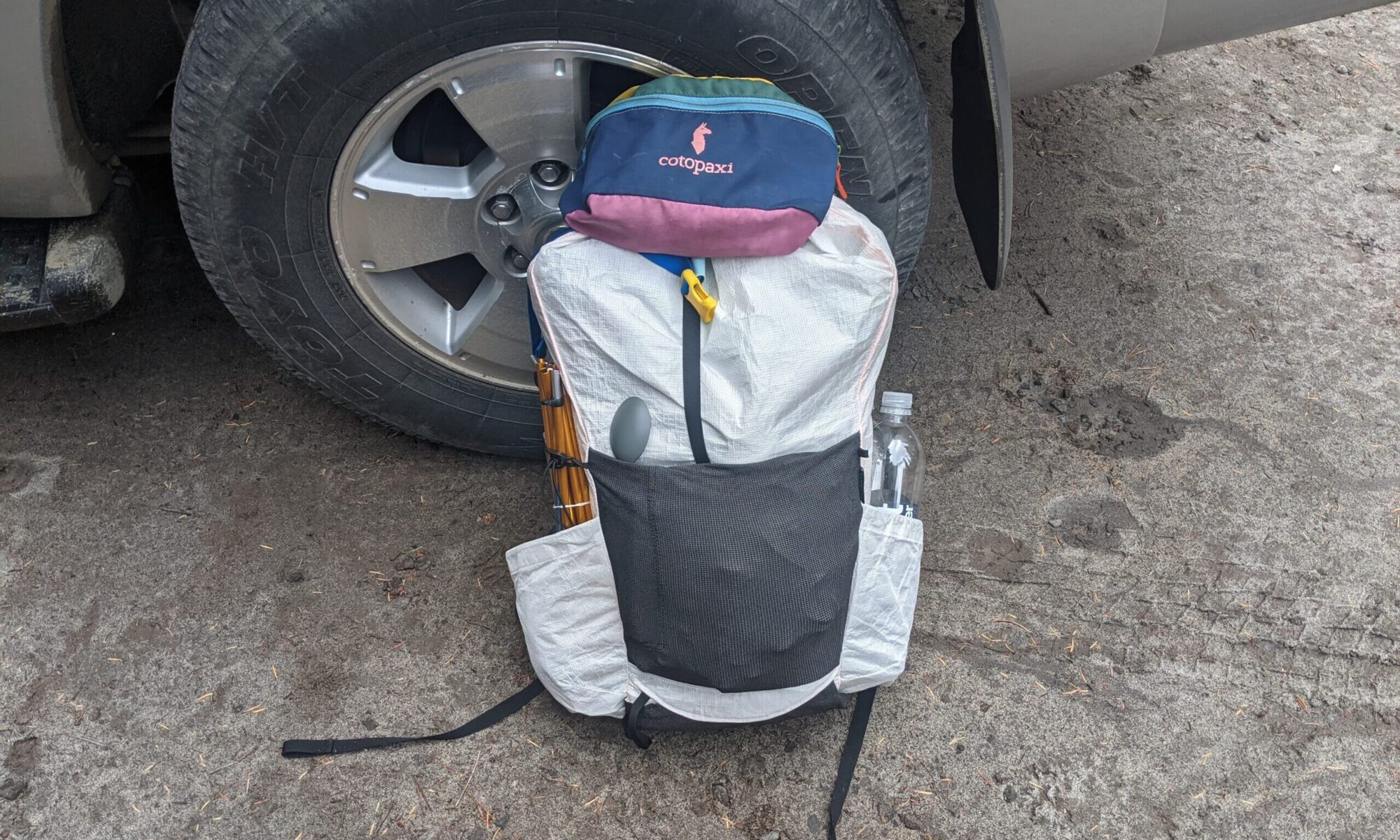
The Palante Desert is available in both 210 gridstop (Dyneema) or 400D Ultra, heavier weight materials than other ultralight backpacks in this test. This should provide substantial durability, and makes the sub 20-ounce weight of the pack that much more impressive. If you’ve been using a frameless (but structured) pack like the Zpacks Arc Haul or the Durston Kakwa 40 for some time and are ready to level up to something even more minimal, this is an excellent choice.
Most Comfortable: Six Moon Designs Swift X
Report Card (Tested by Diana Helmuth with additional input from Jac Mitchell)
- Fit: 5
- Comfort: 5
- Load bearing: 4
- Packability: 4
- Accessibility: 3
- Value: 4
Key Features
- Warranty: Limited lifetime warranty, provides repairs related to expected wear and tear for a fee
- Weight: 38.8 ounces
- Available Torso Sizes: One size (16 inches to 22 inches)
- Available Hip Belt Sizes: Extra small to large (24 inches to 50 inches)
- Shoulder Straps: J-strap, S-strap, or flight option available
- Adjustment Points: Hip belt, hip belt stabilizers, shoulder straps, back panel, load lifters, and two sternum straps
- Frame: Removable Delrin hoop stay frame
- Body Material: LiteSkin LS21 or EPX 200
- Pockets: Two hip belt pockets, two side pockets, front mesh pocket, six shoulder strap pockets
Pros
- Very comfortable, even for those accustomed to traditional backpacks
- Adjusts to a wide variety of body shapes
- Plenty of pockets
Cons
- Takes a while to adjust to this different style of backpack
Plenty of people just can’t get the frame and structure of a backpacking backpack—ultralight or traditional—to work for them. It’s either too stiff or too tight at the hips, pulling at the shoulders or unbalancing them at larger loads. If that sounds like you then the Six Moon Designs Swift X backpack may have that Goldilocks configuration that you’ve been after.
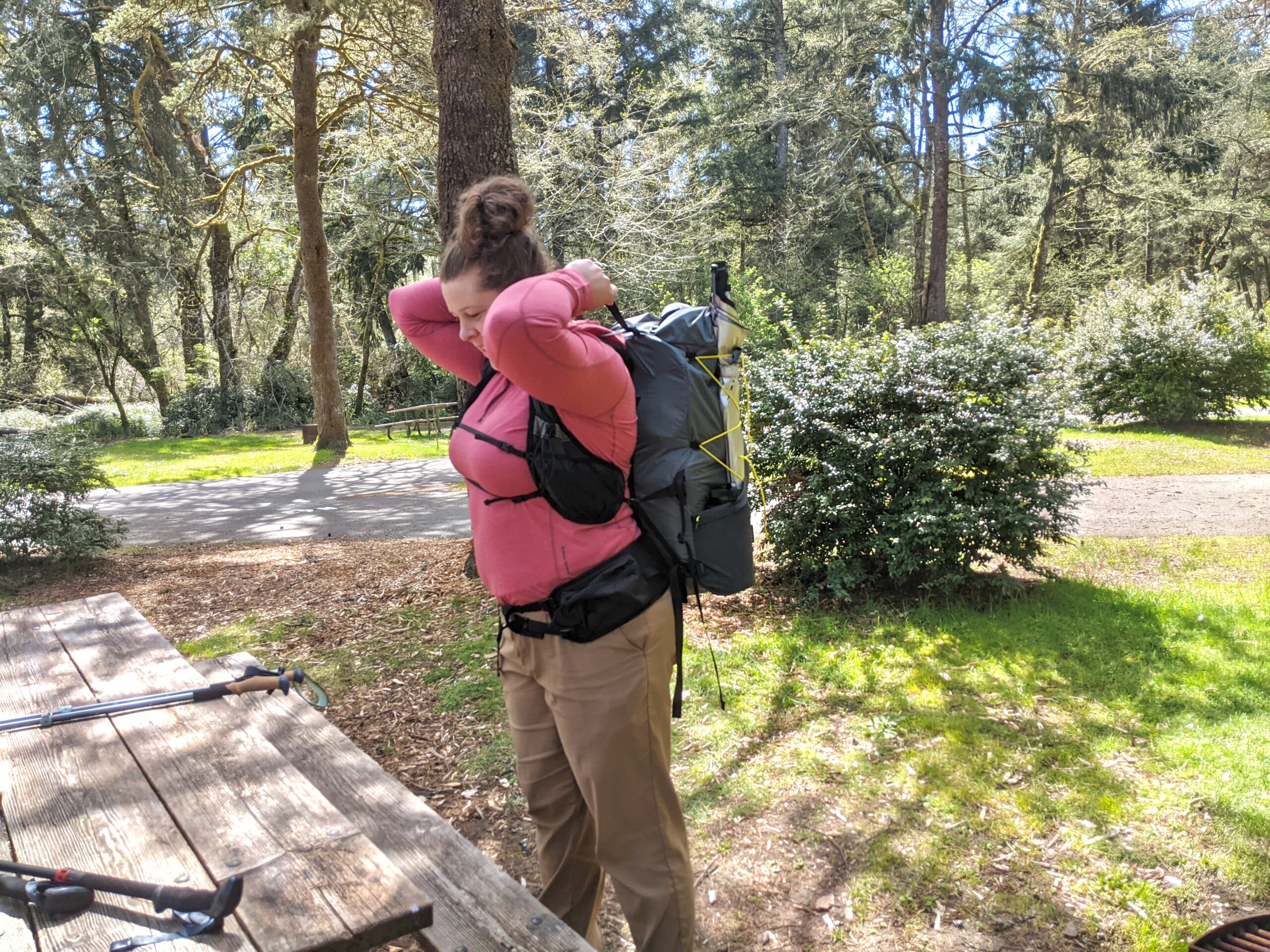
The most experienced tester on our trip—Jac “Top Shelf” Mitchell—had discussed Six Moon Designs vest-style backpack when we interviewed her last fall. Unlike traditional backpacks or framed ultralight backpacks that tend to perch weight on your hips and shoulders, the vest style of backpack conforms more closely to your body, almost hugging you (Six Moon also offers this backpack with a more traditional strap configuration). We were curious to see what Diana Helmuth, one of the testers for our series on the best backpacking backpacks would think of it. Would she miss the more robust internal frame?
Nope. “I had 5 liters of water in that thing, plus the rest of my gear, and I couldn’t believe how my shoulder and hips felt,” she reported. “That was a big eye opener for me compared to my experience with a beefy internal frame.”
I was similarly impressed with the Six Moons Designs pack, particularly the running vest straps when I took this one out into the field. Unlike other ultralight packs I’ve used, this one felt like it had a fully supported frame that was also comfortable to use. And the strap system seemed to work equally well on a wide range of body types—a very thin woman stopped me on my hike and asked about the pack. I helped her adjust it and she said that it was one of the most comfortable packs she had tried. Who ever said ultralight had to be uncomfortable?
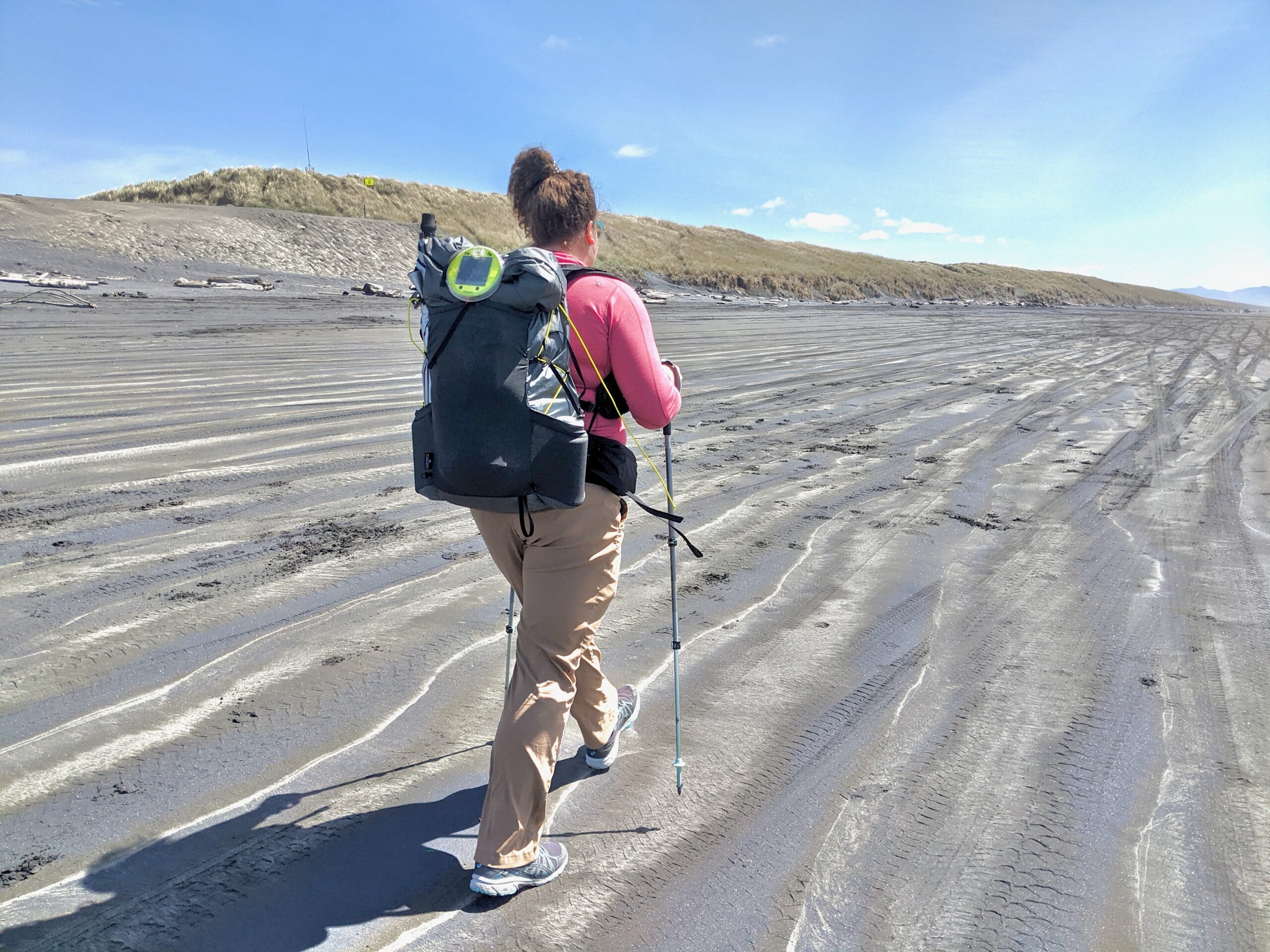
Despite being the heaviest pack we tested by a wide margin, the Six Moon Designs Swift X scored highly for fit and comfort. It also took advantage of the wide running vest harness by adding three pockets onto each side, the most of any backpack that we looked at.
Lightest: Zpacks Arc Haul Ultra 40
Report Card (Tested by Jac Mitchell and Ashley Thess)
- Fit: 3
- Comfort: 3
- Load bearing: 4
- Packability: 3
- Accessibility: 2
- Value: 2
Key Features
- Warranty: Two years
- Weight: 18.8 ounces
- Available Torso Sizes: Short to tall (16 inches to 26 inches)
- Available Hip Belt Sizes: Extra small to extra large (25 inches to 44 inches)
- Shoulder Straps: S-straps
- Adjustment Points: Hip belt, shoulder straps, load lifters, sternum strap
- Frame: Curved carbon fiber air stays
- Body Material: Ultra 200
- Pockets: two side pockets, back mesh pocket
Pros
- Very lightweight
- Great load bearing
- Fits well
Cons
- Expensive
- Fewest pockets in our test
The Zpacks Arc Haul Ultra is exactly what it promises: It strips away everything you don’t absolutely need and uses the absolute lightest materials for everything else. And it does that while staying true to the needs of thru-hikers: It does not skimp on load bearing, boasting both load lifter straps and carbon fiber stays that provide significant structure to this pack.
It does, however, skimp on features—too much, it turned out, for our testers. We should also note that it’s expensive, the most expensive pack we tested. But it does weigh .5 ounce less than the Palante Desert (which doesn’t have load bearing features) and 8.5 ounces less than the Durston Kakwa 40, which does.
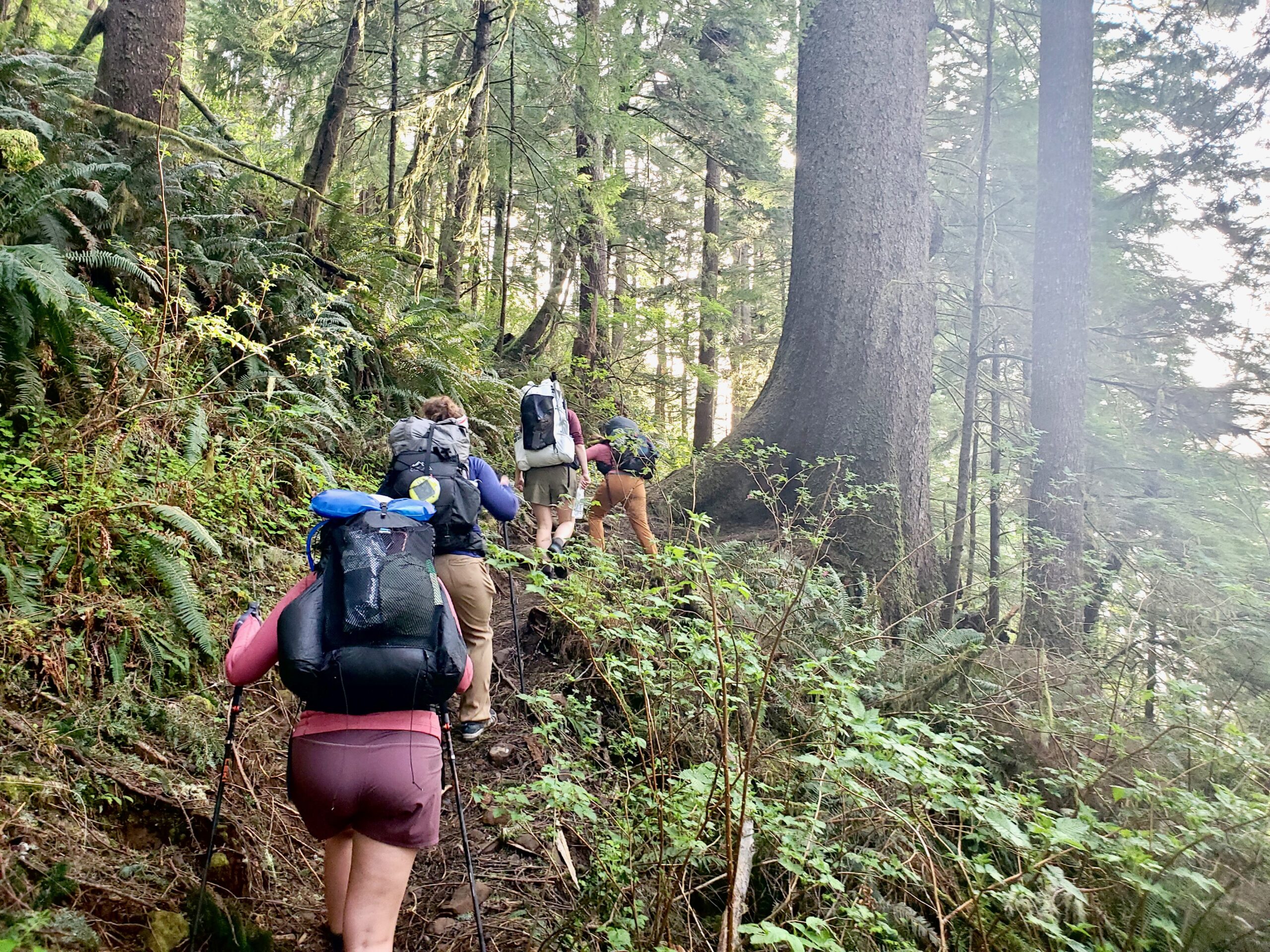
Both of the testers for this pack were impressed with how well the Zpacks Ultra Arc Haul handled the loads typical of ultralight backpackers, thanks in part to the stiff back panel that helped to distribute weight. They even pushed the weight to 26 pounds by strapping a water bladder to the pack during a dry section of the hike. The tester who hauled that load was impressed with how well the Zpacks Ultra Arc Haul handled the additional pounds, given how unideal the setup was. And the adjustments were comfortable and conformed to the testers’ bodies the way they wanted them to. This is, after all, an ultralight backpack’s most important job, and the Zpacks Ultra Arc Haul gets it done.
So what didn’t they like? Both testers struggled with accessibility with the Zpacks Ultra Arc Haul, even compared to similar models like the Durston Kakwa 40 and the Palante Desert. There were no pockets on the hip belts, or on the shoulder straps (Zpacks does sell these as fairly pricey additional add-ons), so to get anything out of their packs they had to stop to take it off. They also had durability concerns with some of the non-Ultra parts of the pack—particularly the mesh on the front pocket.
How to Choose the Best Ultralight Backpack
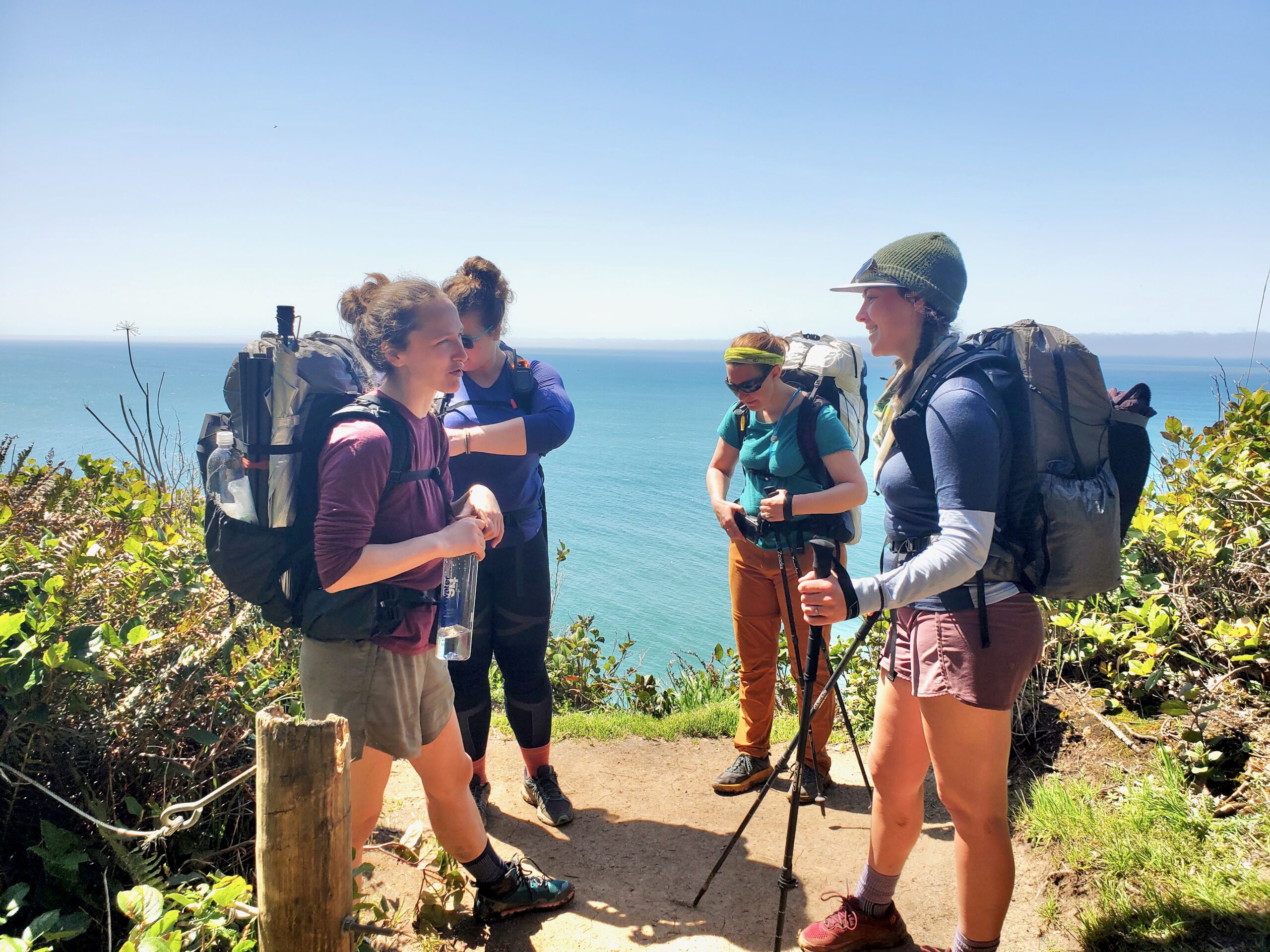
Frame or Frameless
Most backpacks, even ultralight backpacks, have some kind of internal frame or structure, to support the heavier loads that occasionally occur on long-distance treks by transferring some of the weight to your hips. If you plan to forgo any kind of structure to the back panel of your backpack, then aim to keep the total weight of your backpack below twenty pounds. If you’d like to experiment with going frameless without committing, choose a pack with a removable frame.
Packing Your Bag
Packing an ultralight backpack is different from packing a traditional backpacking backpack. These backpacks are essentially a giant tube—pack something at the bottom that you end up needing in the middle of the day and you’re going to have to unpack your entire backpack to retrieve it.
Backpacks without a rigid back panel add another complication: If you pack something stiff or awkwardly shaped in the wrong spot, it’s going to press into your spine until you stop and rearrange everything. For backpacks that lack back panel support, Jac “Top Shelf” Mitchell recommends using a vertical stacking approach (rather than a horizontal one) to give more structure and support to the backpack. Softer items, like the body of a tent, go against the back panel instead of more rigid items, like a cooking pot or food bag. When you’re finished, look at the back panel from the outside and confirm that it has a straight profile before heading out for the day. She noted that an advantage to packing gear into an ultralight backpack is that you typically don’t need to pay as much attention to weight distribution within the backpack, since everything is already lightweight.
Material
The recently released Ultra material has upended the world of ultralight backpacks, and there were a number of backpacks that used this material as their primary body fabric. What makes Ultra unique is its durability and waterproofness (up to 200 PSI) coupled with its low weight. Other popular backpack materials are DCH (a variation of Dyneema) and ripstop nylon (particularly Robic, which is especially tear-resistant). Note that whatever material you choose, the mesh pockets are typically the first part of the backpack to give out.
Fabric thickness is measured in denier, typically shortened to D. Most backpacks we looked at were 200 denier, although some were reinforced or made wholesale out of more robust 400 denier fabric. A few were also thinner; if you choose one of those options, consider the warranty provided and the amount of wear and tear you typically put on your gear.
It has become increasingly common for individuals using packs made entirely or partially from Ultra to forgo rain covers, waterproof pack liners (typically a trash compactor bag), or both. The water resistance of brand-new Ultra is quite high—up to 200 PSI. However, a visual inspection of the ultralight backpacks showed that of the five that used the Ultra material, only one was seam-sealed on the inside (the Zpacks Ultra Arc Haul). When queried, ULA explained that this is because, with enough use, seam sealing will come apart and even the most waterproof material will eventually wet out. In Ultra’s case, this is in part because it gets its water resistance from a lamination: Anywhere on the pack the lamination starts to fail then becomes a potential entry point for water. While Ultra will take on less water weight than other materials, trusting this material to provide long-term protection akin to a dry bag is likely to eventually result in wet gear.
Strap Style
Most ultralight backpacks default to the typical J-strap, rather than the S-strap commonly seen on women’s packs. Our testers (all women) thought they would be bothered by this, but ultimately it wasn’t an issue (at least for most of the packs). There was a preference for the running-vest style straps—which hug your body more than traditional backpacking straps—on the Mountainsmith Zerk and Six Moons Designs Swift X among testers that used those backpacks.
Torso Length
Unlike traditional backpacking backpacks, which often allow you to zero in on the exact torso length for your frame, almost all of the ultralight backpacks we looked at for this test had a fixed torso length (the exception to this is the Six Moons Designs Swift X). During testing, it was clear that whenever you are in-between sizes (say you have a 17-inch torso length and are trying to decide between a small that fits between 15 to 17 inches and a medium that fits 17 inches to 19 inches) that it’s best to size down. Testers could typically get a slightly too-short torso to work fine, but struggled with backpacks that were too long for their frame.
Warranty
Ultralight backpacks can vary widely in their durability. Some of these packs you could carry for 10,000 miles; others of them are going to be shredded by the end of your first thru-hike. In our experience, the warranties provided by the manufacturer often reflect what you can expect, with the most durable packs having multi-year or lifetime warranties, while less durable packs will stop at one year. While we did not test for durability during our section hike of the Oregon Coast Trail, we have included warranty information as part of this review, querying manufacturers when their policy was unclear to us to provide sufficient context for long-distance hikers. Keep in mind that the majority of these warranties will cover repairs to your existing backpack, with full-blown replacements only being provided under select circumstances.
Read Next: The Best Bear Canisters of 2024
FAQs
The benefits of ultralight backpacking depend on your average mileage. If your backpacking trips typically involve hiking five to ten miles to a mountain lake, then lounging in a hammock with a beer, you will likely be happier with a traditional backpacking backpack, which are designed to carry heavier loads comfortably for short distances. If you’re hoping to knock successive 20- or 30-mile days deep into the backcountry, then an ultralight backpack can help reduce the overall load on your legs and feet.
Forty-five liters is a very comfortable size for most backpacking trips, capable of carrying enough food and water for up to five days at a time. Larger 60- or 75-liter packs are a great choice if you plan to head out for more than a week at a time or if you’ll be carrying gear for more than just yourself. Smaller 30-liter packs are typically used by fastpackers to cover very large daily distances (35+ miles), cutting down on the amount of excess food and water they need to carry a time.
While ultralight backpacking can sometimes feel like a race to the bottom—cutting it down to 15 pounds, then 10, then 5—most experienced ultralight backpackers aren’t overly focused on base weight. Different treks will call for different gear sets, have different water carries, longer or further resupply distances. If you’re new to ultralight backpacking, first check the recommended weight limit for your backpack and compare that to the kit you are planning to carry into the backcountry.
Final Thoughts on the Best Ultralight Backpacks
The best ultralight backpacks we looked at for this test spanned a range of styles and approaches, reflecting the creativity and ingenuity of UL cottage company designers. There were packs lacking load lifters, standard hip belts, and back panel frames and structure. However, without fail, all testers reported that they were able to carry plenty of weight comfortably in these packs. Where ultralight backpacks occasionally stymied us was in their approach to organization and accessibility. Each is unique and you’ll need to develop a personal relationship with it to zero in on the perfect packing strategy. But we’re confident that if you’ve been curious about trying out ultralight backpacking, one of the options on this list will change the way you travel in the backcountry:
- Best Overall: ULA Circuit
- Best Value: Mountainsmith Zerk
- Best Availability: Hyperlite 2400 Southwest
- Best Ultra: Durston Kakwa 40
- Best Features: Gossamer Gear Gorilla
- Best Back Panel: Outdoor Vitals CS40 Ultra
- Best for Fastpacking: Palante Desert
- Most Comfortable: Six Moon Designs Swift X
- Lightest: Zpacks Ultra Arc Haul
